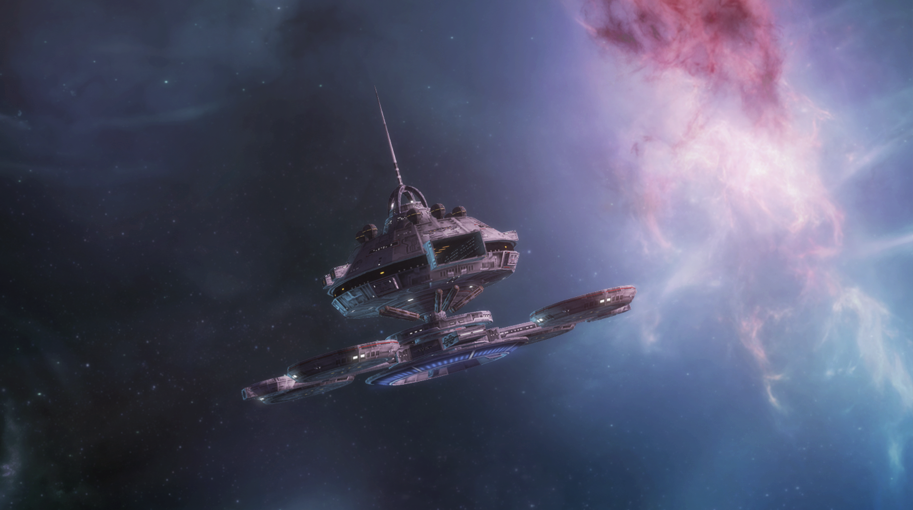Difference between revisions of "User:McGig/Sandbox/Anchorage"
m |
m |
||
| Line 47: | Line 47: | ||
}} | }} | ||
'''''Anchorage''-class stations''' are among the most common stations in the Federation. Based on the same rough planform as the much smaller [[Regula Class|''Regula''-class research station]], the ''Anchorage''-class is intended as a consistent and steady presence of the Federation, acting as a hub for local trade, starship servicing, navigational assistance and static defence. The class serves either as a standalone starbase or as the orbital component of larger planetside bases for smaller colony worlds with underdeveloped space-based infrastructure. | '''''Anchorage''-class stations''' are among the most common stations in the Federation. Based on the same rough planform as the much smaller [[Regula Class|''Regula''-class research station]], the ''Anchorage''-class is intended as a consistent and steady presence of the Federation, acting as a hub for local trade, starship servicing, navigational assistance and static defence. The class serves either as a standalone starbase or as the orbital component of larger planetside bases for smaller colony worlds with underdeveloped space-based infrastructure. | ||
==History== | |||
Coming out of the same program that gave rise to the [[Vision Class|''Vision''-class]] starbases, the ''Anchorage''-class is the largest design that originated from the [[Regula Class|''Regula''-class]] stations. With a commonality of components, design language and a majority of prefabricated components, the ability for the Federation to assemble an ''Anchorage''-class station in a timely fashion allowed for the replacement of strategic and economically important older K-class stations during the middle of the 2300s. | |||
At the time of its original development and deployment, the ''Anchorage''-class was a top-of-the-line facility built with a broad mission scope and with spare capacity to meet the needs of the coming decades. With multiple external hardpoints, the original designers envisioned the class of starbase to be able to be expanded upon and grown until such time as the starbase had organically become the basis of a unique facility, or deemed important enough to warrant replacement with a full scale [[Spacedock Class|''Spacedock''-class]] starbase. | |||
==''Anchorage''-class Stations In-play== | ==''Anchorage''-class Stations In-play== | ||
* | *''Anchorage''-class stations are the older border outposts and guard stations of the Federation, not the mighty floating cities like [[Guardian Class|''Guardian''-class]] stations. With a crew of a thousand aboard they are still respectable-sized stations and continue in their original purpose for the foreseeable future. | ||
* | *Due to their size limitations and the considerations of the era they were designed in, ''Anchorage''-class stations are decent staging posts for fleet actions but are ill-equipped for large-scale repairs and refits, more likely leaning into making ships ready to continue to dedicated repair facilities than undertaking work themselves. | ||
{{clear}} | {{clear}} | ||
Revision as of 09:44, 5 March 2023

| |
| Anchorage Class | |
| Information | |
| Affiliation | |
| Role |
Multi-Role Medium Station |
| Lineage | |
| Preceding Class | |
| Service | |
| Operator | |
| Entered Service |
2349 |
| Endurance | |
| Expected Design Life |
100 years |
| Expected Refit Cycle |
25 years |
| Population | |
| Standard Complement |
1,000 |
| Civilian Residents |
500 |
| Maximum Population |
3,000 |
| Dimensions | |
| Length |
750 meters |
| Width |
1,142 meters |
| Height |
1,713 meters |
| Decks |
82 |
| Propulsion | |
| Propulsion Systems |
10 manuvering thrusters |
| Armaments | |
| Energy Weapons |
18x Type-XII Phaser Arrays |
| Torpedo Launchers |
4x Burst Fire Torpedo Launchers |
| Torpedo Payload |
400 Photon Torpedoes |
| Shields |
Graviton Shields |
| Docking Facilities | |
| Docking Facilities |
|
| Shuttles |
16 |
| Runabouts |
4 |
| Template:Specification | |
Anchorage-class stations are among the most common stations in the Federation. Based on the same rough planform as the much smaller Regula-class research station, the Anchorage-class is intended as a consistent and steady presence of the Federation, acting as a hub for local trade, starship servicing, navigational assistance and static defence. The class serves either as a standalone starbase or as the orbital component of larger planetside bases for smaller colony worlds with underdeveloped space-based infrastructure.
History
Coming out of the same program that gave rise to the Vision-class starbases, the Anchorage-class is the largest design that originated from the Regula-class stations. With a commonality of components, design language and a majority of prefabricated components, the ability for the Federation to assemble an Anchorage-class station in a timely fashion allowed for the replacement of strategic and economically important older K-class stations during the middle of the 2300s.
At the time of its original development and deployment, the Anchorage-class was a top-of-the-line facility built with a broad mission scope and with spare capacity to meet the needs of the coming decades. With multiple external hardpoints, the original designers envisioned the class of starbase to be able to be expanded upon and grown until such time as the starbase had organically become the basis of a unique facility, or deemed important enough to warrant replacement with a full scale Spacedock-class starbase.
Anchorage-class Stations In-play
- Anchorage-class stations are the older border outposts and guard stations of the Federation, not the mighty floating cities like Guardian-class stations. With a crew of a thousand aboard they are still respectable-sized stations and continue in their original purpose for the foreseeable future.
- Due to their size limitations and the considerations of the era they were designed in, Anchorage-class stations are decent staging posts for fleet actions but are ill-equipped for large-scale repairs and refits, more likely leaning into making ships ready to continue to dedicated repair facilities than undertaking work themselves.